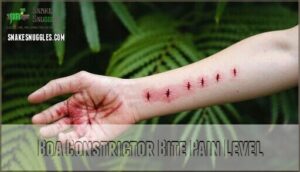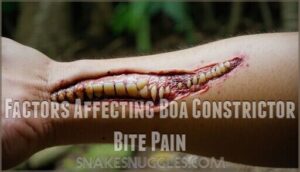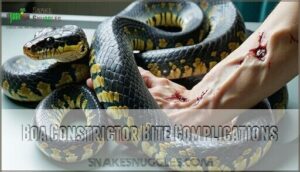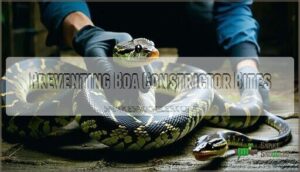This site is supported by our readers. We may earn a commission, at no cost to you, if you purchase through links.
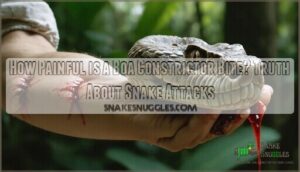
You’ll experience sharp, immediate pain as their backward-curved teeth puncture your skin, but it’s not the excruciating agony you might expect from such an impressive snake.
The pain level depends on the snake’s size, where you’re bitten, and your pain tolerance.
Most people describe it as surprisingly manageable—think "ouch, that stings" rather than "call an ambulance."
While boa constrictors aren’t venomous, their teeth create puncture wounds that bleed and require proper care.
The real secrets lie in understanding what factors make some bites hurt more than others.
Table Of Contents
- Key Takeaways
- How Painful is a Boa Constrictor Bite?
- Boa Constrictor Bite Strength
- Boa Constrictor Bite Pain Level
- Factors Affecting Boa Constrictor Bite Pain
- Boa Constrictor Bite First Aid
- Boa Constrictor Bite Complications
- Preventing Boa Constrictor Bites
- Frequently Asked Questions (FAQs)
- What happens if a boa constrictor bites you?
- What should I do if I get bitten by a boa constrictor?
- Are Boa constrictor bites dangerous?
- Is a boa constrictor venomous?
- Are boa constrictor teeth sharp?
- Is it safe to handle a boa constrictor?
- How bad does a boa constrictor bite hurt?
- What is the least painful snake bite?
- Do you feel pain when a snake bites you?
- Can a boa constrictor hurt a human?
- Conclusion
Key Takeaways
- You’ll feel sharp needle-like pain initially, but it’s manageable – A boa constrictor bite rates around 3/10 on pain scales, feeling like multiple needles puncturing your skin, followed by throbbing that lasts several hours.
- The snake’s size dramatically affects how much it hurts – Juvenile boas cause minimal discomfort, like tiny pinpricks, while adult boas create deeper wounds with significantly more pain and bleeding.
- Where you’re bitten makes a huge difference – Finger and face bites hurt the most due to concentrated nerve endings, while leg bites typically cause less discomfort because of thicker skin.
- Infection poses the real danger, not the bite itself – Since boa constrictors aren’t venomous, your main concern is bacterial infection from their mouth, so you’ll need to clean the wound thoroughly and watch for signs of infection.
How Painful is a Boa Constrictor Bite?
When you’re face-to-face with a boa constrictor bite, expect sharp pain sensations like multiple needles stabbing simultaneously.
A boa’s bite delivers instant needle-sharp pain that’ll make you respect these powerful constrictors immediately.
The bite aftermath brings throbbing discomfort lasting hours, while psychological impact can amplify your pain perception.
Though snake bite pain varies with boa constrictor teeth size, effective pain management starts with understanding that constrictor bite severity depends on the snake’s age and your reaction.
Boa Constrictor Bite Strength
When you’re dealing with a boa constrictor bite, understanding the snake’s jaw muscle power helps you grasp what you’re up against.
These serpents pack a serious punch with their bite force reaching 500-600 PSI.
That’s enough pressure to make you respect their capabilities, even though they’re non-venomous.
Here’s what makes boa constrictor bite strength so formidable:
- Bite force variation increases dramatically with the snake’s size and age
- Teeth penetration depth can reach significant levels due to 60 sharp, serrated teeth
- Size-strength correlation shows larger females deliver more powerful bites than males
- Bite strength evolution has created incredibly efficient gripping mechanisms
- Jaw muscle power in adult specimens is eight times stronger than similar-sized humans
The constrictor bite severity depends heavily on the snake’s size, making proper handling essential for your safety.
While non-venomous, these snakes possess large, sharp teeth capable of inflicting severe lacerations.
Boa Constrictor Bite Pain Level
Understanding a boa constrictor bite’s pain level helps you prepare for potential encounters.
These non-venomous snakes deliver surprisingly intense bite sensations despite lacking venom.
Most people rate the pain around 3 out of 10 on the snake bite pain scale, but bite discomfort varies substantially.
Boa constrictors’ bites often lead to puncture wounds.
Here’s what you’ll experience:
- Initial sharp pain – Multiple needle-like punctures from curved teeth
- Bite sensation intensity – Powerful bite force creates immediate discomfort
- Pain duration – Throbbing ache persists for several hours afterward
- Psychological impact – Shock amplifies your individual pain tolerance and pain perception
Factors Affecting Boa Constrictor Bite Pain
Several key factors determine how much pain you’ll experience from a boa constrictor bite.
The snake’s size, where it bites you, and your personal pain tolerance all play important roles in the intensity of discomfort you’ll feel, as these elements combined create a unique experience of discomfort.
Size of Snake
A boa’s size dramatically affects bite pain intensity.
Juvenile bites feel like tiny pinpricks – barely registering on the snake bite pain scale.
However, adult severity increases substantially with larger specimens.
A full-grown boa’s bite force creates deeper wounds and more bleeding.
Size matters when evaluating constriction risk too.
Bigger snakes pack stronger jaws, sharper teeth, and higher pain levels overall.
Bite Location
Where you get bitten makes a huge difference in your pain level.
Finger bites hurt the most since your hands have tons of nerve endings. Face bites are equally brutal due to sensitive facial nerves.
Leg bites typically cause less discomfort because of thicker skin and muscle.
Bite depth also matters – deeper punctures from larger boas create more intense pain than surface scratches.
Individual Pain Tolerance
Your individual pain tolerance determines how much a boa constrictor bite actually hurts you.
Your pain threshold decides whether a boa bite feels like sharp needles or manageable pinpricks.
Pain thresholds and sensory perception vary dramatically between people.
Prior experiences with injuries, genetic predisposition, and psychological impact from fear all influence your snake bite pain perception.
What feels like sharp needles to one person might seem manageable to another, making pain level highly personal.
Boa Constrictor Bite First Aid
If a boa constrictor bites you, don’t panic—these non-venomous snakes can’t poison you, but their sharp, curved teeth can cause bleeding and infection if you don’t treat the wound properly.
You’ll need to act quickly to clean the bite, stop any bleeding, and watch for signs of infection that could turn a manageable situation into a medical emergency.
Seek Medical Attention Immediately if Bitten
Call emergency services immediately after any boa constrictor bite.
Don’t gamble with your health—even non-venomous bites carry serious infection risk from bacteria in the snake’s mouth.
Large constrictors can cause deep wound care needs and significant bleeding control challenges.
Keep your emergency contact ready, as the psychological impact often amplifies the pain level beyond the actual bite treatment required.
Wash The Bite With Soap and Water
After a boa constrictor bite occurs, you’ll want to clean that wound immediately. Proper snake bite wound cleaning prevents dangerous bacteria from taking hold in your system.
Use warm water and antimicrobial soap to thoroughly wash the area, focusing on infection prevention through careful wound assessment. You can find various types here.
- Use lukewarm water temperature – Hot water can damage tissue further
- Wash for 2-3 minutes washing duration – Don’t rush this critical step
- Apply gentle antimicrobial soap – Regular soap works if that’s unavailable
- Examine the snake bite wound cleaning thoroughly for debris or teeth
- Pat dry carefully – Avoid rubbing which worsens bite treatment needs
Cover The Bite With a Clean, Dry Dressing
After cleaning your boa constrictor bite, proper wound protection becomes your next priority.
Apply a sterile gauze pad directly over the puncture wounds, securing it with medical tape.
This snake bite wound dressing prevents bacteria from entering while controlling bleeding, and effective bandaging techniques create a barrier against infection.
Change the bandage daily or when soiled, and you can find various pad options online, which support your body’s natural healing process with the right dressing materials.
Keep The Bite Area Elevated and Immobilized
After bandaging your snake bite, proper positioning becomes your next priority.
Keep the injured area still and lower than your heart to reduce swelling and minimize movement. This positioning helps promote healing while managing pain effectively.
Here’s your snake bite pain management checklist:
- Elevate the wound below heart level – Reduce swelling naturally
- Apply a broad pressure bandage – Improve circulation around the bite
- Use a splint if needed – Minimize movement for faster recovery
- Avoid walking on bitten limbs – Prevent additional snake bite wound elevation issues
- Monitor for increased pain – Track your body’s healing response
Boa Constrictor Bite Complications
Beyond the initial boa constrictor bite pain, several snake bite complications can emerge that demand your attention.
Infection risks top the list since bacterial colonies thrive in snake mouths, turning those curved tooth punctures into potential breeding grounds for nasty pathogens. You’ll face tissue damage from deep wounds, especially if teeth break off inside your skin.
Scarring often follows severe bites, particularly on sensitive areas like hands or face. Some people experience allergic reactions to proteins in snake saliva, causing additional swelling and discomfort. Don’t overlook psychological trauma either – many bite victims develop lasting fears of snakes.
Safe handling practices are essential to avoid bites.
Watch for snake bite infection signs: increasing redness, warmth, pus, or red streaking. Constrictor bite effects can worsen quickly without proper medical monitoring.
Preventing Boa Constrictor Bites
Now that you understand potential complications, let’s focus on bite prevention – your best defense against a painful encounter.
Safe handling starts with understanding your boa’s temperament recognition. Watch for defensive postures like S-curves or hissing before approaching. Never handle during feeding time or within 48 hours after eating.
Protective gear makes a real difference. Wear thick gloves and long sleeves when handling aggressive snakes. Snake handling requires supporting their body weight evenly – sudden movements trigger defensive bites. For enhanced safety, consider using specialized handling equipment.
Habitat modification reduces risks too. Remove hiding spots where snakes might feel cornered. If you’re new to snake safety, let experienced handlers teach you proper handling techniques first.
Remember: even seasoned keepers get tagged occasionally. The key is minimizing your chances through smart prevention strategies.
Frequently Asked Questions (FAQs)
What happens if a boa constrictor bites you?
Like stepping on a medieval caltrop, you’ll feel sharp needle-like pain as curved teeth puncture your skin.
You’ll bleed substantially from multiple wounds, but there’s no venom.
Clean thoroughly and watch for infection signs, this is crucial to prevent further complications.
What should I do if I get bitten by a boa constrictor?
Clean the wound immediately with soap and warm water.
Remove any lodged teeth with tweezers.
Apply antibiotic ointment and bandage it up.
Watch for infection signs like swelling or redness, and see a doctor if needed.
Are Boa constrictor bites dangerous?
Boa constrictor bites aren’t life-threatening since they’re non-venomous, but you’ll face bleeding, puncture wounds, and infection risks.
Large adults can cause deeper injuries requiring medical attention, especially with their sharp, curved teeth.
Is a boa constrictor venomous?
No, you don’t need to worry about venom from a boa constrictor. They’re completely non-venomous snakes that rely on constriction to subdue prey, not toxic injections like vipers or cobras.
Are boa constrictor teeth sharp?
You’ll definitely feel those needle-like dental tools when they connect with your skin.
Boa constrictors pack sharp, curved teeth that point backward, creating multiple puncture wounds that can leave you counting dozens of holes afterward.
Is it safe to handle a boa constrictor?
Handling a boa constrictor can be safe with proper technique and experience.
You’ll need protective gear, calm movements, and understanding of their behavior.
Support their weight, avoid feeding times, and never handle alone for maximum safety.
How bad does a boa constrictor bite hurt?
You’ll feel sharp pinpricks like multiple needles stabbing at once, followed by throbbing pain.
Adult boas rate about 3/10 on pain scales—uncomfortable but manageable.
The bleeding’s often worse than the actual hurt.
What is the least painful snake bite?
Young boa constrictors deliver the gentlest bites, feeling like an "angry toothbrush" brushing your skin.
You’ll experience minimal pain from these juvenile snakes compared to larger species with stronger jaws and sharper teeth.
Do you feel pain when a snake bites you?
Yes, you’ll definitely feel pain when a snake bites you.
The sharp teeth puncture your skin like multiple needles, causing immediate stinging pain followed by throbbing that can last several hours afterward.
Can a boa constrictor hurt a human?
A boa constrictor can definitely hurt you, but it won’t kill you.
Their sharp, curved teeth cause painful puncture wounds and heavy bleeding.
Adult boas pack enough strength to inflict serious lacerations requiring medical attention.
Conclusion
Understanding how painful is a boa constrictor bite helps you prepare for these unexpected encounters.
While their teeth create sharp puncture wounds, the discomfort remains surprisingly manageable for most people.
You’ll feel immediate stinging followed by throbbing pain, but it’s rarely severe enough to cause panic.
Proper first aid and medical attention prevent complications from infection.
Remember, these snakes bite defensively, not aggressively, and with knowledge and respect, you can safely appreciate these remarkable constrictors from an appropriate distance.
- https://www.healthline.com/health/chronic-pain
- https://healthy.kaiserpermanente.org/health-wellness/health-encyclopedia/he.snake-and-lizard-bites.snake
- https://www.quora.com/Does-a-bite-from-a-constrictor-snake-bite-hurt-more-than-venomous-snake-bites/
- https://commons.wikimedia.org/wiki/File:Boa_constrictor,_Va%C5%88kovka,_Brno_(2).jpg
- https://creativecommons.org/licenses/by-sa/4.0

